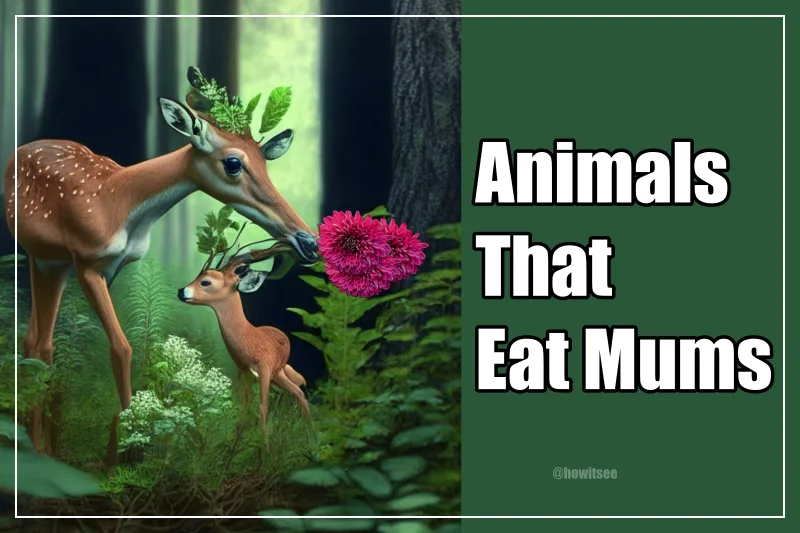Chrysanthemums are commonly admired for their beauty and ornamental value due to their vivid colors and delicate petals. However, it might surprise you to learn that despite their pleasing look and distinct fragrance, these flowering plants can also serve as a source of food for a variety of animals.
We shall delve into the fascinating world of herbivorous creatures in this article, as well as their unexpected affinity for chrysanthemums. We will look at 15 different species, in this article, “What Animals Eat Mums”, their behavior and eating patterns.
From insects and birds to mammals and reptiles, nature presents us with an array of creatures that consume the petals, leaves, or stems of chrysanthemums.
What is Mum and Why do Animals Eat it?
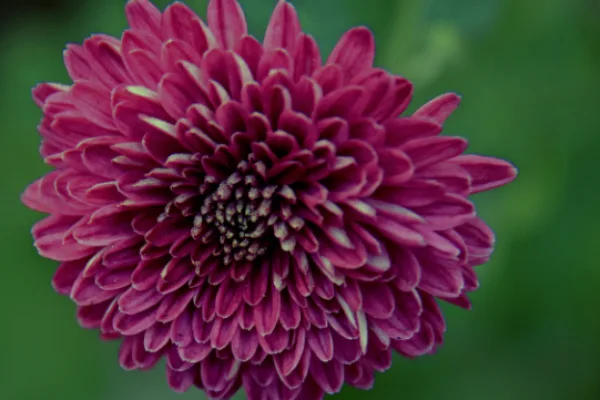
Chrysanthemums, sometimes referred to as Mums, are flowering plants in the Asteraceae family. They are frequently grown for their gorgeous and vibrant flowers and are native to Asia.
Chrysanthemums are popular flowers for gardens, bouquets, and cultural celebrations because they come in a variety of forms, sizes, and colors.
Chrysanthemums are mostly valued for their aesthetic look; however certain animals have come to prefer eating these plants. Animals consume chrysanthemums for a variety of reasons, many of which are influenced by the plant’s unique traits and the animals’ dietary requirements.
Chrysanthemums are rich in Calcium, Phosphorous, Iron, Magnesium, Vitamin C, and several other nutrients. While certain animals may consume chrysanthemums, it’s important to remember that most of these flowering plants are not a substantial source of food for wildlife.
While some animals feed on Mums plants only when other food sources are absent or insufficient, others feed on them for their plant sap.
What Animals Eat Mums?
Animals like insects and mammals feed on Chrysanthemums. This includes animals like Deer, Squirrels, Cabbage Moth, Large Yellow Underwings, etc.
1. Deer

| Family | Cervidae |
| Type of Animal | Mammal |
| Size | Species dependent |
| Habitat | Forests, Grasslands |
| Geographical Location | Asia, Africa, America |
The first animal in this list of What Animals Eat Mums are Deer. Deer eat a range of vegetation, including grasses, shrubs, and trees, and are essentially herbivores. They typically target plants with tender foliage and may browse on garden plants, including chrysanthemums, if they find them accessible and appealing.
The likelihood of deer feeding on mums can be influenced by several factors. In regions where deer populations are high and natural food sources are limited, they may resort to feeding on a wider range of plants, including chrysanthemums.
Additionally, deer may be more inclined to eat mums if they are accessible during times of food shortage, such as during the winter months when other food sources are limited.
2. Rabbit

| Family | Leporidae |
| Type of Animal | Mammal |
| Size | Species dependent |
| Habitat | Forests, woodlands, grasslands |
| Geographical Location | Worldwide |
Since they are herbivores, rabbits naturally like to eat a variety of vegetation, such as flowers, grasses, and vegetables. They often browse plants with succulent leaves that are within their reach, and Chrysanthemums are no exception to it.
Many sources on the internet claim otherwise, because Mums contain Pyrethrum, a toxin transformed into pyrethrin. Rabbits will feed on the leaves and stems of Chrysanthemums when other food sources are scarce.
To prevent Rabbits from nibbling your pretty Mums, you can set up a physical barrier like a mesh, or plant rabbit-deterring plants around your garden.
3. Chrysanthemum Aphid
| Scientific Name | Macrosiphoniella sanborni |
| Type of Animal | Insect |
| Size | 2-2.5 millimeters |
| Habitat | Nurseries, gardens |
| Geographical Location | East Asian origin |
Chrysanthemum aphids are tiny insects that primarily feed on the sap of chrysanthemum plants. Chrysanthemum aphids have specialized mouthparts called stylets, which they use to pierce the plant tissues and extract the sugary sap.
The young leaves, branches, and flower buds of chrysanthemum plants are their main targets since they are nutrient-rich and have a plentiful supply of food.
They squirt saliva containing enzymes into the plant tissues which have the potential to deform and impair the plant’s development. The impacted leaves may curl, become yellow, or develop more slowly than normal.
4. Two Spotted Spider Mite
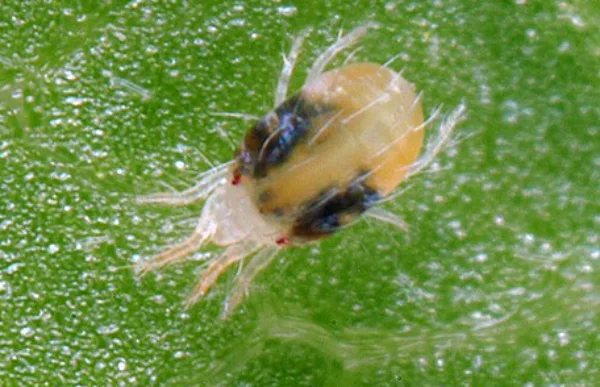
| Scientific Name | Tetranychus urticae |
| Type of Animal | Insect |
| Size | 0.02 inches |
| Habitat | Tree barks, foliage |
| Geographical Location | Eurasia |
The fourth member of this list of What Animals Eat Mums is the Two Spotted Spider Mite. These mites are not selective in their choice of host plants and can infest a wide range of plant species, including ornamental plants like Chrysanthemums.
Two-spotted Spider Mites ingest plant sap by puncturing plant cells and sucking out the liquids. They primarily target the underside of leaves, where they create small feeding punctures.
5. Hebrew Character Moth
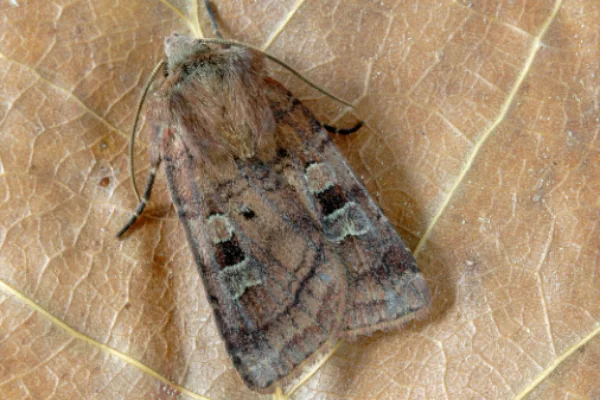
| Scientific Name | Orthosia gothica |
| Type of Animal | Insect |
| Size | Wingspan 30-35 mm |
| Habitat | Gardens, woodlands, marshes |
| Geographical Location | Europe |
The Hebrew Character Moth has a diverse diet, feeding on various plant species, including Chrysanthemums. The caterpillars of the Hebrew Character Moth are the primary feeders.
They have a ravenous appetite and, if present in large enough populations, can cause significant harm to plants. The caterpillars are known to feed on the leaves of Chrysanthemum plants, consuming the tender foliage and occasionally even the flowers.
6. Squirrels
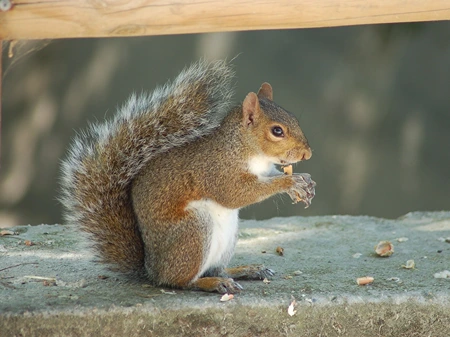
| Family | Sciuridae |
| Type of Animal | Mammal (rodent) |
| Size | Species dependent |
| Habitat | Forests, Gardens, Open areas |
| Geographical Location | Worldwide |
Squirrels eat a variety of foods, including nuts, seeds, fruits, and even plant leaves. They are predominantly herbivores. Chrysanthemums (Mums) are not considered to be a particular favorite, however, squirrels have been observed to eat the leaves or blooms of these plants on occasion.
Due to their opportunistic feeding habits and dietary requirements, squirrels will look for a variety of food sources. In their foraging activities, they may stumble upon chrysanthemums, and out of curiosity or hunger, they may eat the tender stems or the leaves.
It’s crucial to remember that compared to other plant-related problems, squirrel damage to chrysanthemums is rather limited.
7. Angle Shades Moth
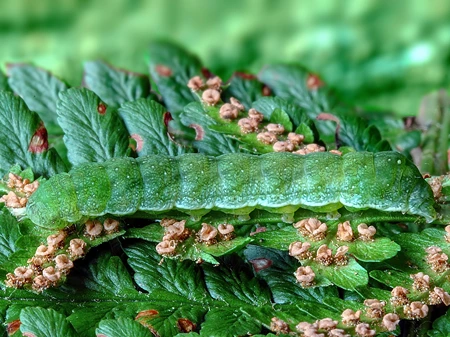
| Scientific Name | Phlogophora meticulosa |
| Type of Animal | Insect |
| Size | 45 millimeters |
| Habitat | Gardens, woodlands, grasslands |
| Geographical Location | Europe |
The next organism on this list of What Animals Eat Mums is the Angle Shades Moth, a nocturnal insect that feeds on a wide range of host plants, including Chrysanthemums. The caterpillars of the Angle Shades Moth play a significant role in its feeding habits.
The pale green or brown color and complex patterns on the caterpillars’ bodies, which resemble dried leaves, give them a unique look and help them blend in well.
Smaller infestations can be controlled by physically removing caterpillars by handpicking or by gently spraying them with water. They are known to eat the foliage and even the flowers of Chrysanthemum plants.
8. Large Yellow Underwing
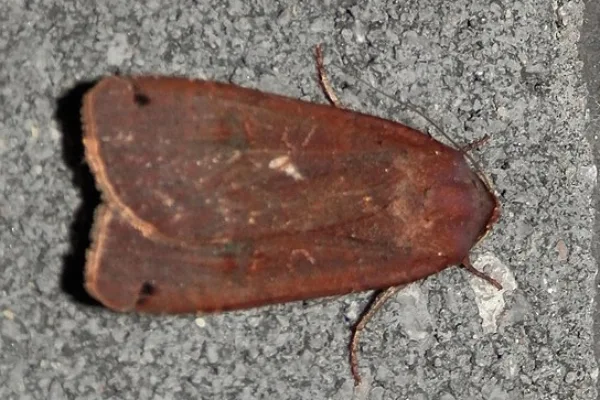
| Scientific Name | Noctua pronuba |
| Type of Animal | Insect |
| Size | 45 millimeters |
| Habitat | Open Grassy Areas |
| Geographical Location | Palearctic realm |
Similar to the other moth species, it is the caterpillars and the larva that feed on plants. The Large Yellow Underwing‘s caterpillars eat a variety of plant types, including shrubs and herbaceous plants.
These plants, especially Chrysanthemums, are known to have their leaves consumed as they mature. They might have darker heads and are green or grey-brown.
Grey or brown bands span the length of the caterpillar. Ways to deter these insects may include the use of natural deterrents like Calendula, soapy water spray, or by handpicking.
9. Cabbage Moth
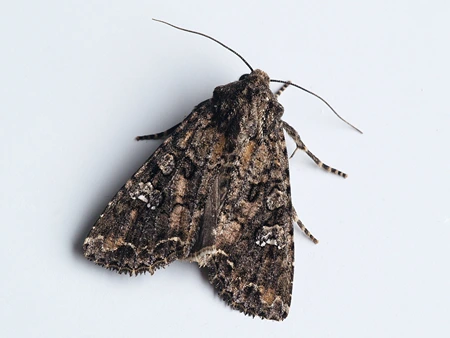
| Scientific Name | Mamestra brassicae |
| Type of Animal | Insect |
| Size | 40 millimeters |
| Geographical Location | Europe, Asia, North Africa |
The first through fourth instars of the caterpillars of the Cabbage Moth cause the most harm. The larvae eat frequently during the first three instars and may skeletonize the leaves on which they settled before migrating.
The larvae tend to move into the center of many fruits, vegetables, and plants during the fourth instar, making them unsuitable for commercial sale. Their feeding activity can weaken the plants and affect their overall growth and appearance.
Additionally, larvae deposit waste materials on the leaves of the host plants, which may further diminish the value of the plant as they bring in a bunch of infections.
10. Gothic Moth
| Scientific Name | Naenia typica |
| Type of Animal | Insect |
| Size | 45 millimeters (larva) |
| Habitat | Gardens, Woodlands |
| Geographical Location | Europe |
Next up on this list of What Animals Eat Chrysanthemums, we have the Gothic Moth Caterpillars, known to eat leaves from a variety of plants and have chewing mouthparts.
They are drawn to plants with delicate leaves in particular, and if Chrysanthemums are nearby and accessible, they might ingest them.
Caterpillars of the Gothic Moth may consume Chrysanthemum leaves, causing obvious damage like holes or chewed edges.
The larva’s coloring might vary, however, it often consists of a blend of brown, grey, and black tones. On their bodies, certain larvae may have stripes or mottling.
11. Turnip Moth
| Scientific Name | Agrotis segetum |
| Type of Animal | Insect |
| Size | 20 millimeters |
| Habitat | Gardens, woodlands, nurseries |
| Geographical Location | Africa, Eurasia |
The Turnip Moth caterpillar is typically brown or gray with a smooth, cylindrical body. It has a voracious appetite and feeds primarily on the foliage of a wide range of plants, including turnips, cabbage, lettuce, and various other vegetable crops.
Chrysanthemums are one of them. The larvae and the caterpillars of the Turnip Moth feed mainly on the leaves of the Mums plant and go from the periphery to the core as it grows through its life stages.
12. Snails
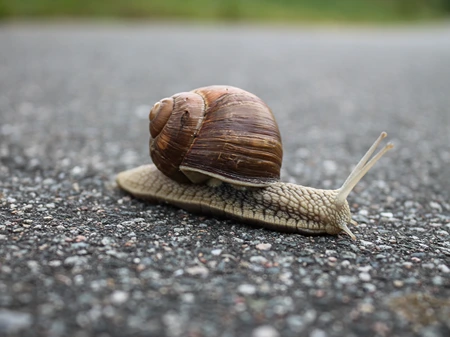
| Class | Gastropoda |
| Type of Animal | Invertebrate- Molluscs |
| Size | Variable |
| Habitat | Grasslands, woodlands, |
| Geographical Location | Worldwide |
It is well known that snails may eat several plants, including Chrysanthemums. They are mollusc gastropods that have spiral-shaped shells that encase soft bodies. Snails are predominantly herbivorous, which means they eat mostly plant material.
They may scrape and rasp at plant surfaces using their radula, a specialized feeding organ containing rows of tiny teeth. With their delicate leaves and pretty blossoms, chrysanthemums may be an alluring food source for snails.
These sluggish animals may creep up on Chrysanthemum plants and start eating the leaves there. Slug baits are a good way to safeguard your mums. Chemical baits with substances like metaldehyde are effective, but they shouldn’t be utilized around kids or animals.
13. Common Swift Moth
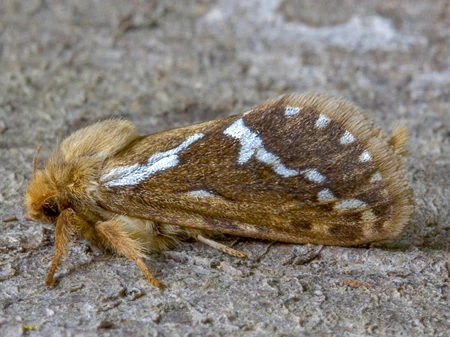
| Scientific Name | Korscheltellus lupulina |
| Type of Animal | Insect |
| Size | 20 millimeters |
| Habitat | Grasslands, gardens, woodlands |
| Geographical Location | Europe |
Next up, on this list of What Animals Eat Mums, we have the Common Swift Moth and its caterpillar. The Common Swift Moth’s larvae, often known as caterpillars, have chewing mouthparts that they utilize to eat plant matter.
They eat plants’ subterranean parts especially the roots, by burrowing into the Earth. In open areas like meadows, pastures, and grassy fields, they frequently feed on grasses, particularly meadow grasses and other herbaceous plants.
It develops into a pupa in a tunnel amid the roots and travels to the surface using the pupa’s spines before emerging.
14. Groundhogs
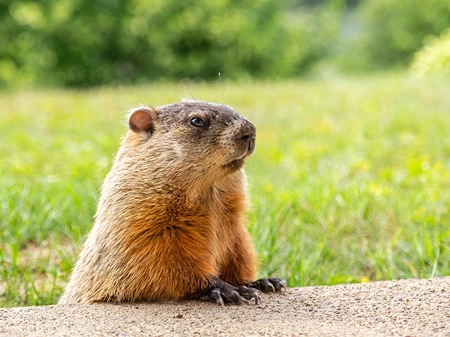
| Scientific Name | Marmota monax |
| Type of Animal | Mammal (rodent) |
| Size | 42-68 centimeters |
| Habitat | Open Country, Woodland edges |
| Geographical Location | North America |
Woodchucks, another name for groundhogs, are herbivorous creatures that mostly eat plants.
Depending on the time of year and the availability of certain plant species, groundhogs forage in the wild. They frequently eat broadleaf plants such as grasses, clover, dandelions, plantains, and others.
Additionally, they have been observed to consume the leaves, stems, and flowers of a variety of garden crops and plants, including lettuce, peas, beans, and carrots. Along with them, they also feed on Chrysanthemums, particularly the delicate stem and leaves.
15. Ghost Moth
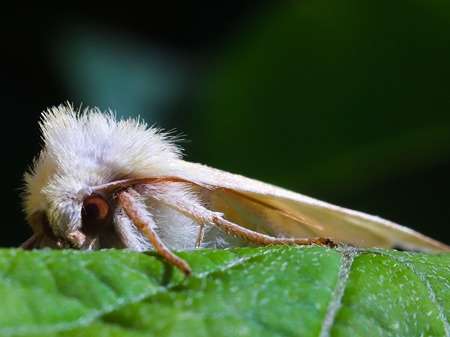
| Scientific Name | Hepialus humuli |
| Type of Animal | Insect |
| Size | 50 millimeters (larva) |
| Habitat | Forests, Gardens |
| Geographical Location | Europe |
The last species in this list of What Animals Eat mums is the Ghost Moth. Larvae of ghost moths are polyphagous, meaning they may eat a variety of plants.
The roots of crops are often fed on by larvae, which can seriously harm the crops. Ghost moths often harm plants including chrysanthemums, lettuce, etc.
Now we come to the end of our today’s article on What Animals Eat Mums. We will be back soon with many more informative articles. So until then, stay tuned.
References:
- WhatAnimalsEat- Mums
- Rabbit Food Guide- Do Rabbits Eat Mums- Risk, Issues and Guide
- The Daily Garden- Large Yellow Underwing Moth
Also Read:

A zoology student turned writer. Nature has always been a magnet to me, and to unearth some of its secrets through my articles is my prime intention. If not engaging myself with nature and anime content, you can always find me going through some Bengali classics or filling the air with some soulful Tabla beats. An artist, trying to throw some colors to my blank canvas of life.
